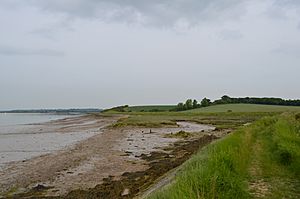The Cliff, Burnham-on-Crouch facts for kids
| Site of Special Scientific Interest | |
 |
|
| Area of Search | Essex |
|---|---|
| Interest | Geological |
| Area | 4.0 hectares |
| Notification | 1986 |
| Location map | Magic Map |
The Cliff, Burnham-on-Crouch is a special natural area in Essex, England. It covers about 4 hectares (that's like 10 football fields!). This site is important because of its geology, which means its rocks and landforms. It sits right on the bank of the River Crouch, between the towns of Burnham-on-Crouch and North Fambridge.
This area is officially called a Site of Special Scientific Interest (SSSI). It's also part of another SSSI called the Crouch and Roach Estuaries, which is important for its wildlife. Scientists also study The Cliff as a Geological Conservation Review site. They learn a lot about ancient birds, fish, and amphibians from the fossils found here.
Contents
What Makes The Cliff Special?
The Cliff, Burnham-on-Crouch, is a unique place for finding very old fossils. These fossils help scientists understand what life was like millions of years ago. It's like a natural history book hidden in the ground!
Discovering Ancient Life: Fossils
Scientists have found amazing fossils at The Cliff. These include fossils of birds from the Lower Eocene period. This was a very long time ago, about 55 to 48 million years ago!
What Bird Fossils Were Found?
Two specific types of ancient birds were first discovered here. Their scientific names are Coturnipes cooperi and Parvicuculus minor. Finding these fossils helps us learn about the birds that lived on Earth long before humans existed.
Fish and Amphibian Fossils
Besides birds, many fossils of ancient fish have been found at The Cliff. Most of these are shark fossils. This site is also where several new species of fish were first identified. Fossils of amphibians, like ancient frogs or salamanders, have also been discovered.
Visiting The Cliff
You can see The Cliff from a path that runs along the riverside. This path goes between Burnham-on-Crouch and North Fambridge. While you can enjoy the view, the actual geological features (like the rocks with fossils) are not visible from the path.

